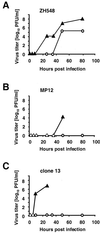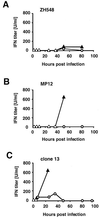Genetic evidence for an interferon-antagonistic function of rift valley fever virus nonstructural protein NSs
- PMID: 11152510
- PMCID: PMC114043
- DOI: 10.1128/JVI.75.3.1371-1377.2001
Genetic evidence for an interferon-antagonistic function of rift valley fever virus nonstructural protein NSs
Abstract
Rift Valley fever virus (RVFV), a phlebovirus of the family Bunyaviridae, is a major public health threat in Egypt and sub-Saharan Africa. The viral and host cellular factors that contribute to RVFV virulence and pathogenicity are still poorly understood. All pathogenic RVFV strains direct the synthesis of a nonstructural phosphoprotein (NSs) that is encoded by the smallest (S) segment of the tripartite genome and has an undefined accessory function. In this report, we show that MP12 and clone 13, two attenuated RVFV strains with mutations in the NSs gene, were highly virulent in IFNAR(-/-) mice lacking the alpha/beta interferon (IFN-alpha/beta) receptor but remained attenuated in IFN-gamma receptor-deficient mice. Both attenuated strains proved to be excellent inducers of early IFN-alpha/beta production. In contrast, the virulent strain ZH548 failed to induce detectable amounts of IFN-alpha/beta and replicated extensively in both IFN-competent and IFN-deficient mice. Clone 13 has a defective NSs gene with a large in-frame deletion. This defect in the NSs gene results in expression of a truncated protein which is rapidly degraded. To investigate whether the presence of the wild-type NSs gene correlated with inhibition of IFN-alpha/beta production, we infected susceptible IFNAR(-/-) mice with S gene reassortant viruses. When the S segment of ZH548 was replaced by that of clone 13, the resulting reassortants became strong IFN inducers. When the defective S segment of clone 13 was exchanged with the wild-type S segment of ZH548, the reassortant virus lost the capacity to stimulate IFN-alpha/beta production. These results demonstrate that the ability of RVFV to inhibit IFN-alpha/beta production correlates with viral virulence and suggest that the accessory protein NSs is an IFN antagonist.
Figures





References
-
- Anderson G W, Jr, Peters C J. Viral determinants of virulence for Rift Valley fever (RVF) in rats. Microb Pathog. 1988;5:241–250. - PubMed
-
- Bancroft J D, Cook H C, Stirling R W, Turner D R. Manual of histological technics and their diagnostic applications. London, U.K: Churchill Livingstone; 1994.
-
- Barnard P, McMillan N A. The human papillomavirus E7 oncoprotein abrogates signaling mediated by interferon-alpha. Virology. 1999;259:305–313. - PubMed
Publication types
MeSH terms
Substances
LinkOut - more resources
Full Text Sources
Other Literature Sources

